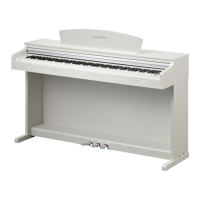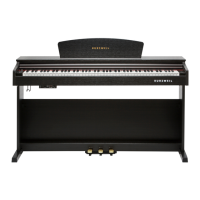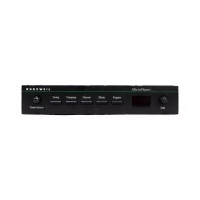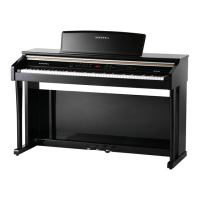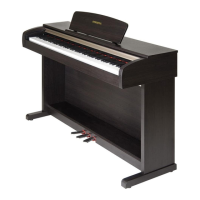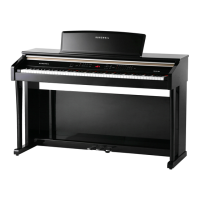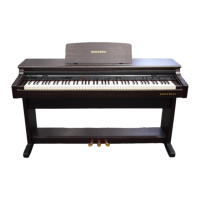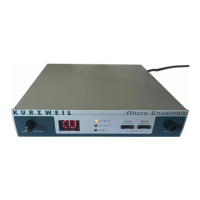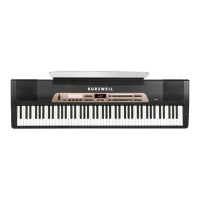Do you have a question about the Kurzweil M115 and is the answer not in the manual?
Safety precautions for using electrical products to prevent fire, shock, or injury.
Information regarding potential interference and compliance with FCC rules.
Warnings related to electrical connection, voltage, and physical handling of the apparatus.
Precautions for safe operation, including static discharge, volume setting, and avoiding internal access.
Contact details for US customers, including address, phone, fax, and email.
Contact details for customers outside the US, including company and website.
Lists the main features of the digital piano, including keyboard, voices, rhythms, and connectivity.
Identifies the various mechanical parts of the M115 piano stand and unit.
Lists all items included in the product packaging, including the main unit and hardware.
Details the accessories provided with the instrument, such as power adapter and cables.
Step-by-step instructions for assembling the side panels and pedal box of the piano stand.
Instructions for attaching the rear panel to the piano stand assembly.
Guide on how to mount the main keyboard unit onto the stand and connect the pedal cable.
Instructions for connecting the power adapter to the piano and an AC outlet.
How to set and adjust the main volume control for optimal sound levels.
Explains the functions of the primary buttons located on the left panel of the instrument.
How to select different instrument sounds using the Voices and Piano buttons.
A comprehensive list of all available instrument voices and their auto-layer counterparts.
Instructions for activating and selecting voices from the General MIDI sound set.
Explains how to combine two different voices across the keyboard for a richer sound.
Details the Auto Layer function, which automatically selects suitable layered voices.
How to adjust the volume level specifically for the Layer Mode.
How to divide the keyboard into two sections, each with a different voice.
How to adjust the volume level for the Split Mode.
Procedure for changing the key that divides the keyboard in Split Mode.
How to enter Function Mode and use buttons to select and adjust settings.
Detailed list of available functions, their ranges, defaults, and descriptions for customization.
Step-by-step guide on how to record and playback performances on the instrument.
Methods for deleting user-recorded songs from the instrument's memory.
How to use Duo Mode for playing duets on the same keyboard.
How to play and control the built-in demonstration songs.
Explains features within Education Mode, including tempo adjustment and practice modes.
How to use the metronome, start/stop rhythms, and adjust tempo.
How to use the transpose function to change the key or octave of the played notes.
Describes the functions of the pedals and notes limitations compared to upright pianos.
Explains the function of each pedal: Sustain, Soft, and Sostenuto.
Explains how MIDI channels are used for transmitting performance data between instruments.
How to connect the instrument to a computer using a USB cable for MIDI communication.
How to configure Local Control to manage the instrument's internal sound engine.
A technical chart detailing MIDI functions, transmitted, and recognized data.
Information on connecting headphones and a warning about hearing loss.
How to connect external audio sources via Audio In and output sound via Audio Out.
Details on USB connectivity for MIDI and connecting the DC power adapter.
How to use the SMART I/O jack for recording with smartphones.
A visual representation and list of drum sounds mapped to specific keys.
A catalog of the 50 demo songs included with the instrument, with composer information.
A list of sonatine pieces categorized by composer and piece number.
A comprehensive list of General MIDI sounds and their corresponding program change numbers.
Detailed technical specifications for the keyboard, polyphony, power, dimensions, and more.
Safety precautions for using electrical products to prevent fire, shock, or injury.
Information regarding potential interference and compliance with FCC rules.
Warnings related to electrical connection, voltage, and physical handling of the apparatus.
Precautions for safe operation, including static discharge, volume setting, and avoiding internal access.
Contact details for US customers, including address, phone, fax, and email.
Contact details for customers outside the US, including company and website.
Lists the main features of the digital piano, including keyboard, voices, rhythms, and connectivity.
Identifies the various mechanical parts of the M115 piano stand and unit.
Lists all items included in the product packaging, including the main unit and hardware.
Details the accessories provided with the instrument, such as power adapter and cables.
Step-by-step instructions for assembling the side panels and pedal box of the piano stand.
Instructions for attaching the rear panel to the piano stand assembly.
Guide on how to mount the main keyboard unit onto the stand and connect the pedal cable.
Instructions for connecting the power adapter to the piano and an AC outlet.
How to set and adjust the main volume control for optimal sound levels.
Explains the functions of the primary buttons located on the left panel of the instrument.
How to select different instrument sounds using the Voices and Piano buttons.
A comprehensive list of all available instrument voices and their auto-layer counterparts.
Instructions for activating and selecting voices from the General MIDI sound set.
Explains how to combine two different voices across the keyboard for a richer sound.
Details the Auto Layer function, which automatically selects suitable layered voices.
How to adjust the volume level specifically for the Layer Mode.
How to divide the keyboard into two sections, each with a different voice.
How to adjust the volume level for the Split Mode.
Procedure for changing the key that divides the keyboard in Split Mode.
How to enter Function Mode and use buttons to select and adjust settings.
Detailed list of available functions, their ranges, defaults, and descriptions for customization.
Step-by-step guide on how to record and playback performances on the instrument.
Methods for deleting user-recorded songs from the instrument's memory.
How to use Duo Mode for playing duets on the same keyboard.
How to play and control the built-in demonstration songs.
Explains features within Education Mode, including tempo adjustment and practice modes.
How to use the metronome, start/stop rhythms, and adjust tempo.
How to use the transpose function to change the key or octave of the played notes.
Describes the functions of the pedals and notes limitations compared to upright pianos.
Explains the function of each pedal: Sustain, Soft, and Sostenuto.
Explains how MIDI channels are used for transmitting performance data between instruments.
How to connect the instrument to a computer using a USB cable for MIDI communication.
How to configure Local Control to manage the instrument's internal sound engine.
A technical chart detailing MIDI functions, transmitted, and recognized data.
Information on connecting headphones and a warning about hearing loss.
How to connect external audio sources via Audio In and output sound via Audio Out.
Details on USB connectivity for MIDI and connecting the DC power adapter.
How to use the SMART I/O jack for recording with smartphones.
A visual representation and list of drum sounds mapped to specific keys.
A catalog of the 50 demo songs included with the instrument, with composer information.
A list of sonatine pieces categorized by composer and piece number.
A comprehensive list of General MIDI sounds and their corresponding program change numbers.
Detailed technical specifications for the keyboard, polyphony, power, dimensions, and more.
| Brand | Kurzweil |
|---|---|
| Model | M115 |
| Category | Musical Instrument |
| Language | English |
